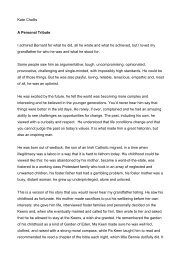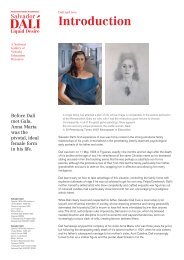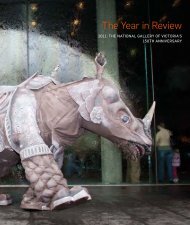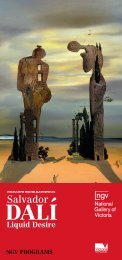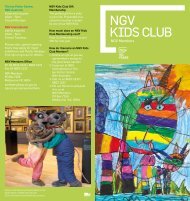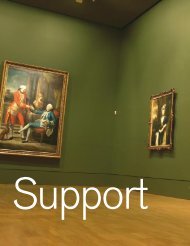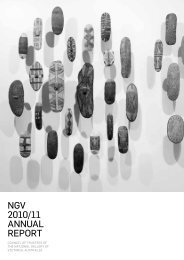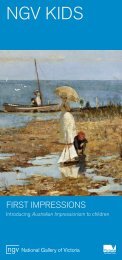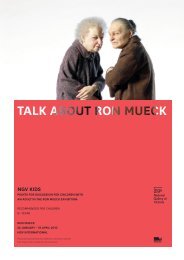Jusepe de Ribera Martyrdom of St Lawrence 1620–24 - National ...
Jusepe de Ribera Martyrdom of St Lawrence 1620–24 - National ...
Jusepe de Ribera Martyrdom of St Lawrence 1620–24 - National ...
Create successful ePaper yourself
Turn your PDF publications into a flip-book with our unique Google optimized e-Paper software.
<strong>Jusepe</strong> <strong>de</strong> <strong>Ribera</strong><br />
<strong>Martyrdom</strong> <strong>of</strong> <strong>St</strong> <strong>Lawrence</strong> <strong>1620–24</strong><br />
un paseo por el arte
<strong>Jusepe</strong> <strong>de</strong> <strong>Ribera</strong><br />
Spanish 1591-1652, worked in Italy c. 1611 -1652<br />
<strong>Martyrdom</strong> <strong>of</strong> <strong>St</strong> <strong>Lawrence</strong> 1620-24<br />
oil on canvas on canvas<br />
206.2 cm x 154.5 cm irreg. (image), 207.5 x 155.2 cm (canvas)<br />
<strong>National</strong> Gallery <strong>of</strong> Victoria, Melbourne<br />
Purchased with funds donated by Allan and Maria Myers<br />
and an anonymous donor, 2006 (2006.390)<br />
The painter and printmaker <strong>Jusepe</strong> <strong>de</strong> <strong>Ribera</strong> was born in Valencia,<br />
Spain, in 1591. He spent his entire career in Italy, becoming one <strong>of</strong><br />
the most important figures in European painting in the seventeenth<br />
century and one <strong>of</strong> the major artists <strong>of</strong> the Counter-Reformation.<br />
<strong>Ribera</strong> was strongly influenced by Caravaggio, a painter <strong>of</strong> dramatic<br />
contrasts <strong>of</strong> tone and lighting, whose work he saw in Rome and<br />
Naples. Although <strong>Ribera</strong> never returned to Spain, his Spanish i<strong>de</strong>ntity<br />
remained important to him. He frequently signed his work ‘hispanus’<br />
(Latin for ‘Spanish’), ‘valentinus’ (‘from Valencia’) and ‘setabensis’<br />
(‘from Játiva’) and he came to be known as ‘lo Spagnoletto’.<br />
This is <strong>Jusepe</strong> <strong>de</strong> <strong>Ribera</strong>’s earliest surviving multi-figure<br />
religious composition. It is possible that it was painted as a major<br />
altarpiece for the Church <strong>of</strong> San Lorenzo in Lucina, Rome.<br />
It <strong>de</strong>picts the martyrdom <strong>of</strong> Saint <strong>Lawrence</strong>, which took place<br />
in Rome un<strong>de</strong>r the persecution <strong>of</strong> Emperor Valerian on 10 August<br />
258. Saint <strong>Lawrence</strong> was a Spanish-born Deacon <strong>of</strong> the church<br />
and keeper <strong>of</strong> its treasure, which is said to have inclu<strong>de</strong>d the Holy<br />
Grail. He is <strong>of</strong>ten shown by artists in the act <strong>of</strong> distributing alms to<br />
the poor. When he was instructed by the pagan emperor to hand<br />
over the valuables <strong>of</strong> the Church, Saint <strong>Lawrence</strong> hid the most<br />
important Christian relics and divi<strong>de</strong>d the remaining wealth among<br />
the needy. In a further act <strong>of</strong> impu<strong>de</strong>nce, he then gathered the poor<br />
<strong>of</strong> Rome and presented them to Valerian, <strong>de</strong>claring them the ‘true<br />
treasures’ <strong>of</strong> the Church. Valerian immediately or<strong>de</strong>red his execution.<br />
According to traditional accounts, Saint <strong>Lawrence</strong> was martyred by<br />
being roasted alive on a gridiron after severe beating and torture.<br />
<strong>Lawrence</strong>’s faith gave him so much strength, however, that he retained<br />
consciousness on the gridiron and even asked his executioners<br />
to turn him over, explaining that he was ‘done’ on one si<strong>de</strong>.<br />
<strong>Ribera</strong> shows Saint <strong>Lawrence</strong> moments earlier, stripped <strong>of</strong> his<br />
church robes, following his beating, when he has accepted his fate and<br />
is contemplating reunion with his maker. <strong>Lawrence</strong>’s left hand points<br />
to sprigs <strong>of</strong> laurel intertwined with a thorny briar along the bottom <strong>of</strong><br />
the painting. Saint <strong>Lawrence</strong>’s name <strong>de</strong>rives from the Latin laurentius<br />
or laurelled; the pairing <strong>of</strong> these two forms may possibly symbolise a<br />
parallel between Saint <strong>Lawrence</strong>’s martyrdom and Christ’s Passion.<br />
<strong>Ribera</strong>’s renowned talent as a painter <strong>of</strong> realistic effects<br />
is particularly evi<strong>de</strong>nt in this picture, in the warts and facial<br />
imperfections <strong>of</strong> the torturers and in the bruising and dirty<br />
fingernails <strong>of</strong> their victim. The painting was so admired in its day<br />
that at least eight versions <strong>of</strong> it were subsequently ma<strong>de</strong>.<br />
Laurie Benson (adapted by Sophie Matthiesson)<br />
<strong>Jusepe</strong> <strong>de</strong> <strong>Ribera</strong><br />
Español (1591) –1652, activo en Italia (hacia 1611)–1652<br />
El martirio <strong>de</strong> San Lorenzo, (<strong>1620–24</strong>)<br />
óleo sobre lienzo<br />
206,20 cms x 154,50 cms irreg. (imagen), 207,50 x 155,20 cms (lienzo)<br />
Galería Nacional <strong>de</strong> Victoria, Melbourne<br />
Adquirido con fondos donados por Allan and Maria<br />
Myers y un donante anónimo, 2006 (2006.390)<br />
El pintor y grabador <strong>Jusepe</strong> <strong>de</strong> <strong>Ribera</strong> nació en Valencia, España,<br />
en 1591. Pasó toda su vida pr<strong>of</strong>esional en Italia y llegó a ser una <strong>de</strong><br />
las figuras más importantes <strong>de</strong> la pintura europea <strong>de</strong>l siglo XVII y uno<br />
<strong>de</strong> los más <strong>de</strong>stacados artistas <strong>de</strong> la Contrarreforma. Caravaggio,<br />
pintor <strong>de</strong> dramáticos contrastes <strong>de</strong> luces y sombras, y cuya obra<br />
pudo ver en Roma y Nápoles, tuvo una gran influencia en <strong>Ribera</strong>.<br />
Aunque <strong>Ribera</strong> nunca volvió a España, su i<strong>de</strong>ntidad española fue<br />
siempre importante para él: con frecuencia firmaba sus obras como<br />
“hispanus”, “valentinus” o “setabensis” (<strong>de</strong>l latín: español, valenciano,<br />
<strong>de</strong> Játiva, respectivamente) y era conocido como “Lo Spagnoletto”.<br />
Este cuadro es el más antiguo que se conserva <strong>de</strong> <strong>Ribera</strong> <strong>de</strong><br />
composición religiosa con múltiples figuras. Es posible que fuera<br />
pintado como pieza principal <strong>de</strong>l retablo <strong>de</strong> la Iglesia <strong>de</strong> San Lorenzo<br />
en Lucina, Roma. Refleja el martirio <strong>de</strong> San Lorenzo que tuvo lugar<br />
el 10 <strong>de</strong> agosto <strong>de</strong> 208 en Roma durante la persecución <strong>de</strong>l<br />
Emperador Valeriano.<br />
S. Lorenzo, nacido en España, era diácono <strong>de</strong> la Iglesia y guardián<br />
<strong>de</strong> su tesoro, que, según la tradición, contenía el Santo Grial. A menudo,<br />
los artistas lo han representado dando limosnas a los pobres. Cuando<br />
el emperador pagano le or<strong>de</strong>nó que entregara los bienes <strong>de</strong> la Iglesia,<br />
S. Lorenzo escondió los más valiosos y repartió el resto entre los<br />
necesitados. A<strong>de</strong>más, en un acto <strong>de</strong> <strong>de</strong>safío, reunió a todos los pobres<br />
<strong>de</strong> Roma y los presentó a Valeriano <strong>de</strong>clarando que ellos eran “el<br />
verda<strong>de</strong>ro tesoro” <strong>de</strong> la Iglesia. Valeriano or<strong>de</strong>nó inmediatamente su<br />
ejecución. Según la tradición, fue asado vivo en una parrilla tras haber<br />
sido golpeado y torturado severamente, pero su fe le dio tal fuerza<br />
que se mantuvo consciente sobre la parrilla e, incluso, pidió a los<br />
verdugos que le dieran la vuelta porque ya estaba “hecho” por un lado.<br />
<strong>Ribera</strong> pinta a S. Lorenzo momentos antes, <strong>de</strong>spojado <strong>de</strong> su<br />
hábito, <strong>de</strong>spués <strong>de</strong> ser azotado, cuando ya había aceptado su<br />
<strong>de</strong>stino y esperaba su reunión con el Creador. La mano izquierda <strong>de</strong><br />
San Lorenzo apunta a un ramo <strong>de</strong> laurel entretejido con una zarza<br />
espinosa que aparece en la parte <strong>de</strong> abajo <strong>de</strong> la pintura. El nombre<br />
S. Lorenzo <strong>de</strong>riva <strong>de</strong>l latín laurentius o laureado y el emparejamiento<br />
<strong>de</strong> estos dos elementos, laurel y espina, probablemente simbolice el<br />
paralelismo entre el martirio <strong>de</strong> San Lorenzo y la Pasión <strong>de</strong> Cristo.<br />
El famoso talento <strong>de</strong> <strong>Ribera</strong> como pintor realista es evi<strong>de</strong>nte en esta<br />
obra en las verrugas e imperfecciones <strong>de</strong> las caras <strong>de</strong> los torturadores<br />
y en las heridas y uñas sucias <strong>de</strong> su víctima. El cuadro fue tan admirado<br />
en su época que se hicieron otras ocho versiones sobre el mismo tema.
Thinking and discussing before the visit<br />
• What is a martyr? Discuss all the reasons why <strong>de</strong>pictions <strong>of</strong> martyrdom have<br />
been popular with artists throughout the history <strong>of</strong> Christianity?<br />
• What effects might seeing an image <strong>of</strong> martyrdom have had on viewers in<br />
the seventeenth century? Why might those effects be different today?<br />
• The Fine Arts Museum <strong>of</strong> Seville has an extensive collection <strong>of</strong> works by the<br />
seventeenth-century religious artist Francisco <strong>de</strong> Zurbarán, some <strong>of</strong> which are online.<br />
• Locate his painting <strong>of</strong> La Virgen <strong>de</strong> las Cuevas, c.1655, using the following:<br />
http://www.junta<strong>de</strong>andalucia.es/cultura/museos/MBASE/in<strong>de</strong>x.<br />
jsp?redirect=S2_3_1_1.jsp&idpieza=47&pagina=2<br />
• In what ways has the artist emphasised the importance <strong>of</strong> the Virgin.<br />
• What elements <strong>of</strong> the painting suggest sadness?<br />
• How has the artist suggested balance and harmony? What<br />
might they symbolise in the context <strong>of</strong> this painting?<br />
• Which other elements <strong>of</strong> the painting could be interpreted as symbols <strong>of</strong> meaning?<br />
• Describe the colours the artist has used. How do they contribute<br />
to the mood and message <strong>of</strong> the painting?<br />
• How might illiterate seventeenth-century viewers looking<br />
at this work for the first time have reacted?<br />
• Locate and discuss paintings by Abstract Expressionist artist Mark Rothko<br />
(1903–1970) who aimed to create a calm, contemplative atmosphere<br />
in his art, which communicated a powerful spiritual experience.<br />
• The artist expressed his intention in the following statement: ‘The people who weep<br />
before my pictures are having the same religious experience I had when I painted them.<br />
And if you are moved only by the colour relationships, then you miss the point’.<br />
• Discuss the reasons that may explain why artists today are less<br />
likely to <strong>de</strong>pict religious imagery than in the past.<br />
Gallery visit activities<br />
• What are your first thoughts when you look at the painting? How does it make you feel?<br />
• What does it make you won<strong>de</strong>r?<br />
• Describe what you can see? What do you think is happening?<br />
• What clues in the painting suggest how Saint <strong>Lawrence</strong> will be executed?<br />
• What evi<strong>de</strong>nce is there to suggest that Saint <strong>Lawrence</strong> has already been mistreated?<br />
• If you pressed ‘play’, what would happen next, if you pressed ‘rewind’, what would you see?<br />
• How has the artist used tone to great effect in this painting. Consi<strong>de</strong>r three-dimensional<br />
form, atmosphere and <strong>de</strong>liberate focus on particular parts <strong>of</strong> the painting.<br />
• How has the artist suggested that Saint <strong>Lawrence</strong> has accepted his fate and put his trust in<br />
God? Consi<strong>de</strong>r the expression on his face, the direction <strong>of</strong> his gaze and his body language.<br />
• Create a newspaper headline that encapsulates the<br />
action and i<strong>de</strong>as suggested by the painting.<br />
Why do you believe art from<br />
different times and cultures has<br />
played an important role in religion<br />
and spiritual life? Consi<strong>de</strong>r images<br />
from Ancient Greek, Roman and<br />
Egyptian civilizations, Aboriginal<br />
cultures and world religions such<br />
as Christianity and Buddhism.<br />
Discuss the purpose and the context<br />
in which they were displayed.<br />
Useful link<br />
http://www.blakeprize.com.au/<br />
Research and discuss works <strong>of</strong><br />
art by finalists in the Blake Prize,<br />
the ol<strong>de</strong>st art prize in Australia<br />
<strong>de</strong>dicated to spirituality, religion<br />
and cultural diversity. Compare<br />
the mediums and materials the<br />
artists used. Discuss in what ways<br />
they are different and similar.<br />
Discuss to what extent art can<br />
inspire us. Prepare an illustrated<br />
talk or a newspaper article<br />
<strong>de</strong>scribing a work <strong>of</strong> art that<br />
has caused you to have this<br />
experience (it may not necessarily<br />
be categorised as ‘religious’ art).<br />
Chiaroscuro is a term in art for<br />
contrast between areas <strong>of</strong> lightness<br />
and darkness. Why might the artist<br />
have used it in this painting?<br />
un paseo por el arte
Gallery visit activities, continued<br />
• Saint <strong>Lawrence</strong>’s name is <strong>de</strong>rived from the Latin laurentius or laurelled. Why might the artist<br />
have intertwined sprigs <strong>of</strong> laurel leaf with a thorny vine along the bottom edge <strong>of</strong> the painting?<br />
• Look at the painting close up and from the other si<strong>de</strong> <strong>of</strong> the gallery. How<br />
do the different views alter your perception <strong>of</strong> the painting?<br />
• Describe the surface texture <strong>of</strong> the paint. How might the<br />
artist have achieved this <strong>de</strong>gree <strong>of</strong> smoothness?<br />
• The painting was probably displayed in a dark church. What<br />
qualities would candlelight have ad<strong>de</strong>d to the painting?<br />
• Discuss the consecutive processes the artist would have worked<br />
through in or<strong>de</strong>r to realise the finished painting.<br />
• Why might the artist have ma<strong>de</strong> this painting? Consi<strong>de</strong>r<br />
who may have commissioned it and why.<br />
• What does the painting reveal about the artist himself?<br />
• How might this painting be perceived differently by an atheist<br />
or someone from a non-Christian background?<br />
• To what extent is this image <strong>of</strong> martyrdom still relevant today?<br />
• While in the gallery, visit another religious painting by Spanish artist Bartolomé<br />
Esteban Murillo (1617–1682) entitled The Immaculate Conception c.1665.<br />
Post-visit activities<br />
• Using libraries and the internet, research the life and works <strong>of</strong> José <strong>de</strong> <strong>Ribera</strong>.<br />
• Research the life and works <strong>of</strong> Italian seventeenth-century artist Caravaggio.<br />
What elements <strong>of</strong> his work suggest that he strongly influenced <strong>Ribera</strong>?<br />
Christ <strong>of</strong> <strong>St</strong> John <strong>of</strong> the Cross, 1951, is a famous religious painting by the Spanish<br />
artist Salvador Dalí. It is owned by the Kelvingrove Art Gallery and Museum, Glasgow,<br />
and has been reproduced many times in books, as posters and on the internet.<br />
Locate the image in a book or on the following website:<br />
http://www.theglasgowstory.com/image.php?inum=TGSE00477<br />
• Describe the unusual angle from which Christ has been<br />
painted. Why might Dalí have chosen this view?<br />
• Why might Dalí have chosen not to show Christ’s face?<br />
• What makes Dalí’s painting significantly different from traditional portrayals <strong>of</strong> the<br />
crucifixion? Consi<strong>de</strong>r what elements Dalí has left out which are normally visible.<br />
• Discuss what you believe Dalí’s intention was when he painted this image.<br />
What does the light from<br />
the fire emphasise about<br />
the executioners’ faces?<br />
Why might this particular<br />
martyrdom <strong>of</strong> Saint <strong>Lawrence</strong> have<br />
been popular with artists? (Titian,<br />
Tintoretto and Zurbarán have all<br />
painted versions <strong>of</strong> this subject.)<br />
Consi<strong>de</strong>r the opportunities it allows<br />
artists to display their talents.<br />
Locate <strong>Ribera</strong>’s painting, Jacob’s<br />
Dream, 1620, based on a story from<br />
the Old Testament at the Prado<br />
Museum in Madrid. Compare<br />
it with The <strong>Martyrdom</strong> <strong>of</strong> Saint<br />
<strong>Lawrence</strong>. List all the differences<br />
and similarities you can find.<br />
http://www.museo<strong>de</strong>lprado.es/en/<br />
ingles/collection/on-line-gallery/online-gallery/obra/jacobs-dream/<br />
Compare <strong>Ribera</strong>’s painting, The<br />
<strong>Martyrdom</strong> <strong>of</strong> Saint <strong>Lawrence</strong><br />
with other famous <strong>de</strong>pictions <strong>of</strong><br />
the crucifixion, including Spanish<br />
artists such as Bartolomé Esteban<br />
Murillo (1618–1682), Francisco<br />
<strong>de</strong> Goya y Lucientes (1746–1828)<br />
and Pablo Picasso (1881–1973).<br />
Picasso’s Crucifixion, 1930, can be<br />
located at the following website:<br />
http://www.abcgallery.com/P/<br />
picasso/picasso96.html<br />
In each case consi<strong>de</strong>r the following:<br />
The purpose <strong>of</strong> the image,<br />
the materials and techniques,<br />
representation <strong>of</strong> the figures and<br />
space, and evi<strong>de</strong>nce <strong>of</strong> symbolism.



